

This section contains the following topics:
Use Case 1: Single Sign-on Based on Account Linking
Use Case 2: Single Sign-on Based on User Attribute Profiles
Use Case 3: Single Sign-on with No Local User Account
Use Case 6: WS-Federation Signout
Use Case 7: Identity Provider Discovery Profile
Use Case 8: Multi-protocol Support
Use Case 9: SAML 2.0 User Authorization Based on a User Attribute
Use Case 10: SAML 2.0 Single Sign-on with No Name ID at the IdP
Use Case 11: SAML Artifact SSO Using Security Zones
Use Case 12: SAML 2.0 SSO Using Attributes from a Web Application
Use Case 13: SSO with Dynamic Account Linking at the SP
In Use Case 1, smcompany.com contracts with a partner company, ahealthco.com to manage employee health benefits.
An employee of smcompany.com authenticates at an employee portal at his company’s site, www.smcompany.com and clicks a link to view her health benefits at ahealthco.com. The employee is taken to the ahealthco.com web site and is presented with her health benefit information without having to sign on to the website.
The following illustration shows this use case.
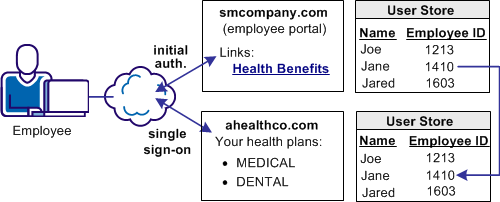
The company, ahealthco.com, maintains all health-related information for employees at smcompany.com. To do this, ahealthco.com maintains user identities for every employee of smcompany.com. When an employee of smcompany.com accesses ahealthco.com, an identifier for the employee is passed from smcompany.com to ahealthco.com in a secure manner. This identifier allows ahealthco.com to determine who the user is and the level of access to allow for that user.
Solution 1 illustrates how legacy federation can be deployed at smcompany.com and ahealthco.com to solve Use Case 1: Single Sign-on Based on Account Linking.

CA SiteMinder® is deployed at both sites. The Web Agent with the Web Agent Option Pack are installed on a webserver system and the Policy Server is installed on another system. The installations are the same for smcompany.com and ahealthco.com.
Note: The SPS federation gateway can replace the Web Agent and Web Agent Option Pack to provide the Federation Web Services application functions. For information about installing and configuring the SPS federation gateway, see the Secure Proxy Server Administration Guide.
In this example, smcompany.com is acting as the producer site. When an employee of smcompany.com accesses an employee portal at www.smcompany.com, the sequence of events is as follows:
Ahealthco.com is acting as the consumer site. The SAML credential collector service handles the redirect request of the SAML artifact. The credential collector is part of the Federation Web Services application at ahealthco.com.
The sequence of events is as follows:
In this example, the administrator at smcompany.com configures an affiliate for ahealthco.com. The affiliate is configured with an attribute that is a unique ID for the user. This action causes the assertion generator to include that attribute as part of the user profile in a SAML assertion that is created for ahealthco.com.
The administrator at ahealthco.com configures a SAML artifact authentication scheme for smcompany.com. The authentication scheme specifies the location of the assertion retriever service at smcompany.com. The scheme also extracts the unique user ID from the SAML assertion, determines how to search the ahealthco.com user directory for the user record that matches the value from the assertion.
In this example, smcompany.com is acting as the producer site. When an employee of smcompany.com accesses an employee portal at www.smcompany.com, the sequence of events is as follows:
Ahealthco.com is acting as the consumer site. The SAML credential collector service handles the redirect request with the SAML response. The SAML credential collector that is part of the Federation Web Services at ahealthco.com.
The sequence of events is as follows:
In this example, the administrator at smcompany.com uses the UI to configure an affiliate object for ahealthco.com. The affiliate is configured with an attribute that is a unique ID for the user. This action causes the assertion generator to include that attribute as part of the user profile in a SAML assertion that is created for ahealthco.com.
The administrator at ahealthco.com configures a SAML POST profile authentication scheme for smcompany.com. The authentication scheme specifies how to extract the unique user ID from the SAML assertion. The scheme also defines how to search the user directory at ahealthco.com for the user record that matches the value from the assertion.
In this example, smcompany.com is acting as the Identity Provider. When an employee of smcompany.com accesses an employee portal at www.smcompany.com, the sequence of events is as follows:
Ahealthco.com is acting as the Service Provider. One of the components of the Service provider is the Assertion Consumer Service. The Assertion Consumer Service handles the redirect request containing the SAML artifact.
The sequence of events is as follows:
In this example, the administrator at smcompany.com configures a Service Provider object for ahealthco.com. The Service Provider is configured with an attribute that is a unique ID for the user. This action causes the assertion generator to include that attribute as part of the user profile in an assertion that is created for ahealthco.com.
The administrator at ahealthco.com configures a SAML 2.0 authentication scheme that uses the artifact binding for smcompany.com. The authentication scheme has the following information:
In this example, smcompany.com is acting as the Identity Provider. When an employee of smcompany.com accesses an employee portal at www.smcompany.com, the sequence of events is as follows:
Ahealthco.com is acting as the Service Provider. The Assertion Consumer Service handles the redirect request with the SAML response. The service is part of the Federation Web Services at ahealthco.com.
The sequence of events is as follows:
In this example, the administrator at smcompany.com configures a Service Provider object for ahealthco.com. The Service Provider is configured with an attribute that is a unique ID for the user. This action causes the assertion generator to include that attribute as part of the user profile in a SAML assertion that is created for ahealthco.com.
The administrator at ahealthco.com configures a SAML 2.0 authentication scheme with the HTTP-POST binding for smcompany.com. The authentication scheme has the following information:
In this example, smcompany.com is acting as the Account Partner. When an employee of smcompany.com accesses an employee portal at www.smcompany.com, the sequence of events is as follows:
Ahealthco.com is acting as the Resource Partner. The Security Token Consumer Service handles the redirect request with the SAML response. The service is part of the Federation Web Services application.
The sequence of events is as follows:
In this example, the administrator at smcompany.com configures a Resource Partner object for ahealthco.com. The Resource Partner is configured to include an attribute in the assertion that is a unique ID for the user. The assertion generator includes that attribute in the SAML assertion for ahealthco.com.
The administrator at ahealthco.com configures a WS-Federation authentication scheme for smcompany.com. The authentication scheme has the following information:
In Use Case 2, smcompany.com buys parts from a partner named partsco.com.
An engineer authenticates at the employee portal, smcompany.com and clicks a link to access information at partsco.com. Being an engineer at smcompany.com, the user is taken directly to the Specifications portion of the partsco.com website without having to log in.
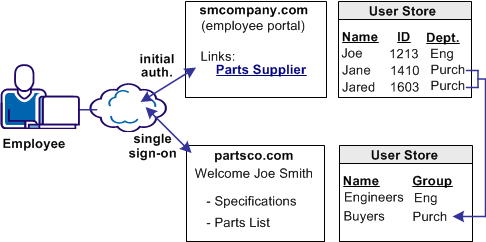
When a buyer for smcompany.com authenticates and clicks a link for partsco.com, the buyer is taken directly to the Parts List portion of the partsco.com website. The buyer does not have to log in.
Additional attributes, such as the user name are passed from smcompany.com to partsco.com to personalize the interface for the individual user.
Partsco.com does not want to maintain user identities for all employees at smcompany.com, but the company wants to control access to sensitive portions of the website. To control the access, partsco.com maintains a limited number of profile identities for users at smcompany.com. One profile identity is maintained for engineers and one profile identity is maintained for buyers.
When an employee of smcompany.com accesses partsco.com, smcompany.com sends user attributes in a secure manner to partsco.com. Partsco.com uses the attributes to determine what profile identity controls access.
Solution 2 shows how Federation Security Services can be deployed at smcompany.com and partsco.com to solve Use Case 2: Single Sign-on Based on User Attribute Profiles.
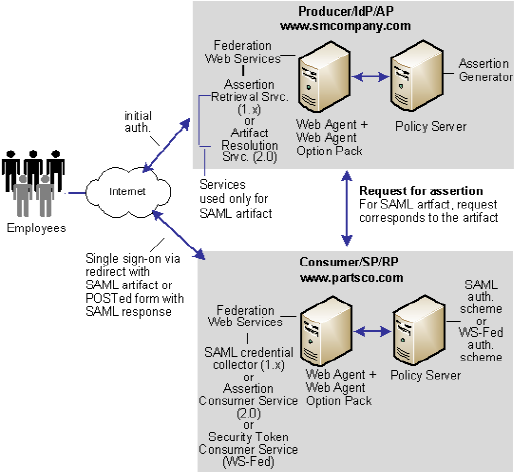
CA SiteMinder® is deployed at both sites. The interactions between the user and each site is similar, where partsco.com is acting as the relying party.
The following illustration is similar for SAML 1.x, SAML 2.0, and WS-Federation; however, the Federation Web Services components are different as follows:
Note: WS-Federation only supports HTTP-POST binding.
Note: The SPS federation gateway can replace the Web Agent and Web Agent Option Pack to provide the Federation Web Services application functions. For information about installing and configuring the SPS federation gateway, see the Secure Proxy Server Administration Guide.
The configuration is similar to Solution 1: Single Sign-on based on Account Linking, except for the following items:
In Use Case 3, smcompany.com offers employee discounts by establishing a partnership with discounts.com.
An employee of smcompany.com authenticates at smcompany.com and clicks a link to access discounts.com. The employee is taken to the discounts.com website and presented with the discounts available for smcompany.com employees, without logging in to the discounts.com website.
The following illustration shows this use case.
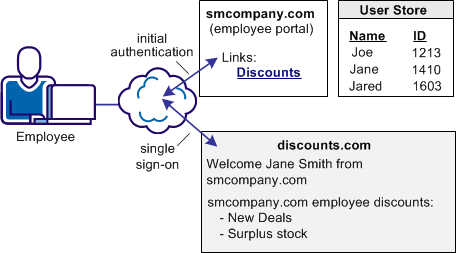
Discounts.com does not maintain any identities for smcompany.com. The company allows all employees of smcompany.com to access discounts .com as long as long as they have been authenticated at smcompany.com. When an employee of smcompany.com accesses discounts.com, authentication information is sent in a secure manner from smcompany.com to discounts.com. This information is used to allow access to discounts.com.
Additional attributes, such as the user name are passed from smcompany.com to discounts.com to personalize the interface for the individual user.
Solution 3 shows how CA SiteMinder® legacy federation can be deployed at smcompany.com and discounts.com to solve Use Case 3: Single Sign-on with No Local User Account.
CA SiteMinder® is deployed at smcompany.com by installing the Web Agent with the Web Agent Option pack on one system, and installing the Policy Server on another system. The SAML Affiliate Agent is installed at discounts.com.
Note: The SAML Affiliate Agent only supports SAML 1.0 and is not FIPS-compatible.
The following figure shows single sign-on with no local user account.
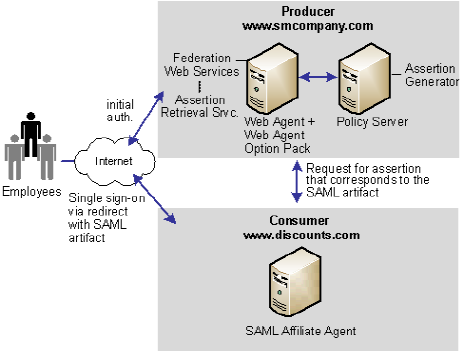
Note: The SPS federation gateway can replace the Web Agent and Web Agent Option Pack to provide the Federation Web Services application functions. For information about installing and configuring the SPS federation gateway, see the Secure Proxy Server Administration Guide.
Smcompany.com is acting as a SAML 1.x producer. When an employee of smcompany.com accesses an employee portal at www.smcompany.com, the following process occurs:
Discounts.com is acting as the consumer site. The SAML Affiliate Agent at www.discounts.com handles the redirect request with the SAML artifact, as follows:
The administrator at smcompany.com uses the Policy Server User Interface to configure an affiliate for discounts.com. The affiliate is configured to include attributes in the assertion. The assertion generator includes the attributes in the SAML assertion it creates for discounts.com.
The administrator at discounts.com configures the SAML Affiliate Agent with information about the discounts.com site, the location of the assertion retriever service at smcompany.com, and the resources the affiliate protects.
In Use Case 4, smcompany.com, ahealthco.com, and discounts.com all participate in an extended federated network. This case is an extension of the previous use cases.
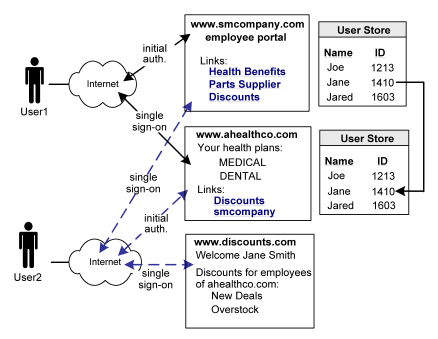
In this network, not all customers of ahealthco.com work at smcompany.com. Ahealthco.com provides discounts only to its customers by establishing a relationship between themselves and discounts.com. Ahealthco.com maintains user identities for every customer so ahealthco.com manages local credentials, such as a password for each user. By managing local credentials, ahealthco.com can authenticate users and can provide single sign-on access to its partners.
In this extended network, the users access each website differently:
User2 authenticates at the ahealthco.com website and clicks a link to access discounts at discounts.com, without logging in to the discounts.com website. The discounts the site presents to User2 reflect the business arrangement between ahealthco.com and discounts.com. Being employee of smcompany.com, User2 can also click a link at ahealthco.com and access the employee portal at smcompany.com without logging in to website.
Solution 4 illustrates how legacy federation can be deployed at smcompany.com, ahealthco.com, and discounts.com to solve Use Case 4: Extended Networks.
The following illustration shows an extended network. SAML 1.x is the protocol in use.
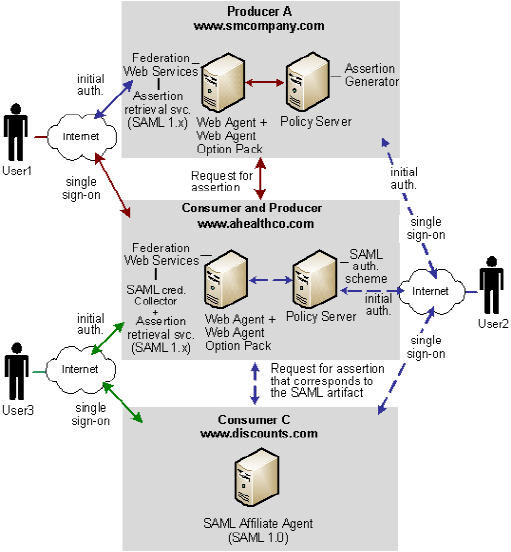
Note: The SPS federation gateway can replace the Web Agent and Web Agent Option Pack to provide the Federation Web Services application functions. For information about installing and configuring the SPS federation gateway, see the Secure Proxy Server Administration Guide.
CA SiteMinder® is deployed at smcompany.com and ahealthco.com. At each site, the Web Agent and Web Agent Option Pack is installed on one system and the Policy Server on another system. The SAML Affiliate Agent is installed at discounts.com.
In Solution 4:
The administrator for smcompany.com has configured two entities in an affiliate domain, which represents ahealthco.com and discounts.com. These sites are configured in a similar manner as in Examples 1 and 3 described previously, but the configurations have been extended as follows:
In Use Case 5, an employee of smcompany.com authenticates at an employee portal, smcompany.com, and selects a link to view the health benefits at ahealthco.com. The employee is taken to the ahealthco.com website and presented with the health benefit information without logging in to the site.
After the employee logs out from ahealthco.com, the site wants to verify the termination of the user session at ahealthco.com and at smcompany.com. Terminating both sessions prevents an unauthorized employee from using the existing session to access resources at smcompany.com or to view benefits of the authorized employee.
Note: The initial logout can occur at smcompany.com and result in both sessions being terminated.
The following illustration shows the use case.
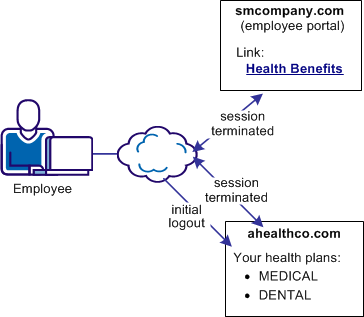
Solution 5 illustrates how federation can be employed to solve Use Case 5: Single Logout.
In this solution:
The following figure shows the CA SiteMinder® solution for single logout.
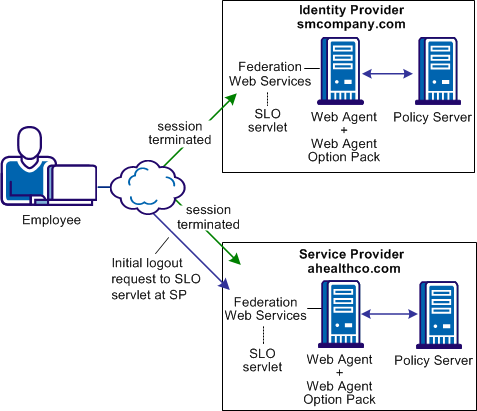
Note: The SPS federation gateway can replace the Web Agent and Web Agent Option Pack to provide the Federation Web Services application functions. For information about installing and configuring the SPS federation gateway, see the Secure Proxy Server Administration Guide.
The sequence of events is as follows:
Note: The termination does not remove the session from the session store; it sets the state to LogoutInProgress.
Note: Other Service Providers are not identified in the illustration.
Terminating both sessions prevents an unauthorized employee from using the existing session to view benefits of the authorized employee.
In Use Case 6, an employee of smcompany.com authenticates at the employee portal. The employee then selects a link to view health benefits at ahealthco.com. The employee is taken to the ahealthco.com website and presented with the health benefit information without having to sign on to the site.
When the employee logs out, ahealthco.com wants the user session at its site and at smcompany.com terminated. Terminating both sessions prevents an unauthorized person from using the existing sessions to access resources at smcompany.com or ahealthco.com.
The following illustration shows the use case.
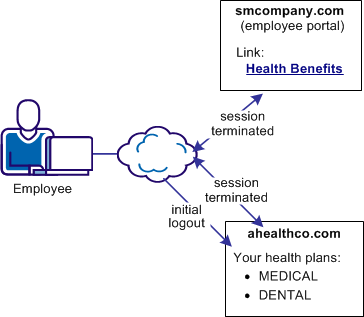
Solution 6 illustrates how federation solves Use Case 6: WS-Federation Signout.
In this solution:
WS-Federation signout is enabled at the Account Partner and the Resource Partner.
The following figure illustrates WS-Federation sign-out.
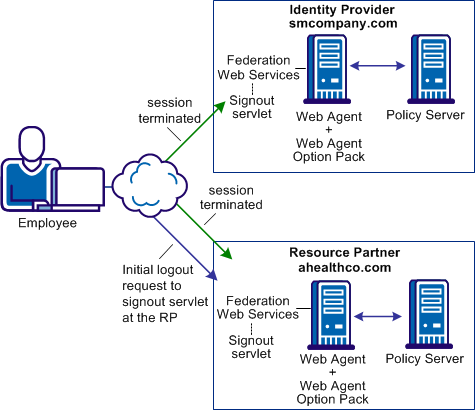
Note: The SPS federation gateway can replace the Web Agent and Web Agent Option Pack to provide the Federation Web Services application functions. For information about installing and configuring the SPS federation gateway, see the Secure Proxy Server Administration Guide.
The sequence of events is as follows:
The SignoutConfirm page generates a frame-based HTML page with each frame containing a signoutcleanup URL for each Resource Partner that is associated with the user session.
Steps 4-6 are repeated for each Resource Partner simultaneously for complete signout for that user session.
In Use Case 7, several companies contract health benefits from ahealthco.com. When a user requests logs on to ahealthco.com to view their health benefits, ahealthco.com must determine which Identity Provider it sends an authentication request to for a particular user.
IdP discovery is useful in federated networks that have more than one partner providing assertions. It provides a dynamic way for a Service Provider to determine which Identity Provider it sends authentication requests for a particular user.
The following illustration shows a network with the Identity Provider Discovery profile in use.
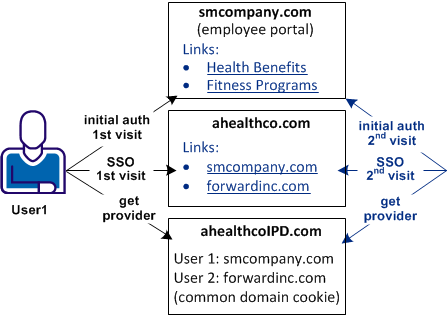
A user arrives at ahealthco.com. This health provider determines where to send the authentication request. For User1, smcompany.com is where this user authenticates, so this company is set in the common domain cookie at ahealthco.com. For another user, forwardinc.com is an Identity Provider where a user authenticates. Forwardinc.com is set in the common domain cookie at ahealthco.com also.
A prior business agreement between the sites in this network exists so that all sites interact with the Identity Provider Discovery service.
Solution 7 illustrates how CA SiteMinder® legacy federation can solve Use Case 7: Identity Provider Discovery Profile.
In this solution:
The following illustration shows the federated network for this solution.
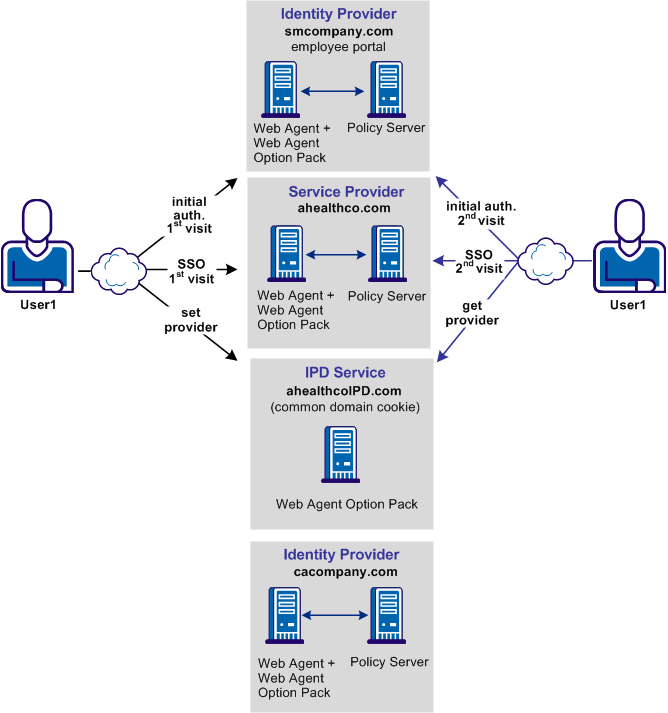
Note: The SPS federation gateway can replace the Web Agent and Web Agent Option Pack to provide the Federation Web Services application functions. For information about installing and configuring the SPS federation gateway, see the Secure Proxy Server Administration Guide.
The sequence of events is as follows:
An agreement exists between smcompany.com and ahealthcoIPD.com to use ahealthcoIPD.com as the IPD service. During the initial authentication process, the Identity Provider URL of smcompany.com is written to the common domain cookie at the IPD service.
In Use Case 8, smcompany.com issues assertions for ahealthco.com and discounts.com. Ahealthco.com uses SAML 2.0 for User1 to communicate between smcompany.com and ahealthco.com. Discounts.com uses SAML 1.0 for User2 to communicate between smcompany.com and discounts.com. The assertions must be suitable for the protocol that the SP uses to consume the assertion.
The following illustration shows the multiprotocol use case.
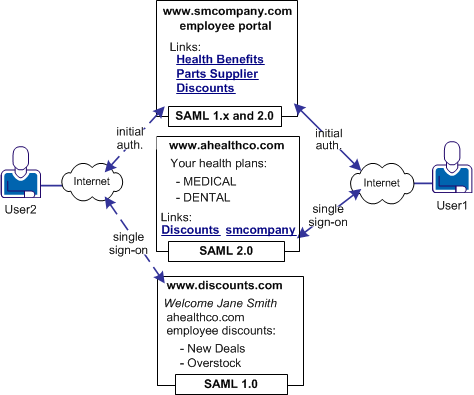
Solution 8 illustrates how CA SiteMinder® legacy federation can solve Use Case 8: Multi-protocol Support.
In this solution:
The following illustration shows a CA SiteMinder® federated network that implements multiprotocol support.
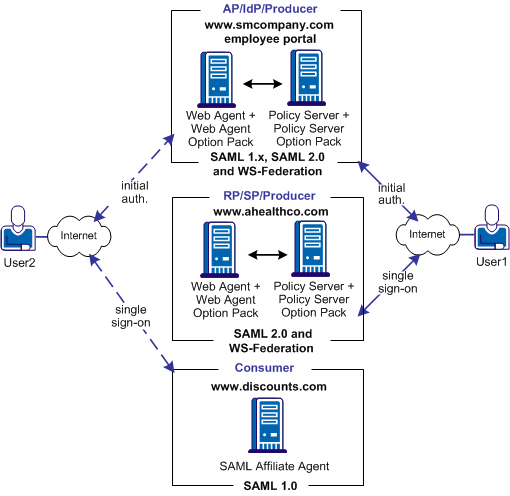
Note: The SPS federation gateway can replace the Web Agent and Web Agent Option Pack to provide the Federation Web Services application functions. For information about installing and configuring the SPS federation gateway, see the Secure Proxy Server Administration Guide.
In this multiprotocol solution, smcompany.com can issue a SAML 2.0 assertion for User 1 to access resources at ahealthco.com. Additionally, smcompany.com can issue a SAML 1.0 assertion for User 2 to authenticate at discounts.com. Smcompany.com issues an assertion that is based on the session cookie that is set during initial authentication and determines the appropriate protocol for the assertion.
Configure the SAML Affiliate Agent at discounts.com. The smcompany.com is added to its producer information settings in its AffiliateConfig.xml configuration file so that it accepts SAML 1.0 assertions from this site.
In Use Case 9, forwardinc.com is a car rental service and exampleair.com is a travel agency.
A customer of forwardinc.com logs in and authenticates at forwardinc.com, then clicks a link at the site to get a quote for a car rental. The customer profile at forwardinc.com includes the customer frequent flyer number for exampleair.com. The frequent flyer account determines a certain status level at forwardinc.com. The status level determines which discount offers the customer receives for car rentals.
The following illustration shows this use case.
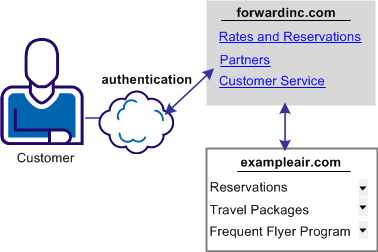
Forwardinc.com wants to present the appropriate discount information to its customers. However, it does not want customers to log in and authenticate at exampleair.com first then having to log in again at its site.
The SAML 2.0 Attribute Query/Response profile can solve Use Case 9: SAML 2.0 User Authorization Based on a User Attribute.
Note: This solution is only for SAML 2.0.
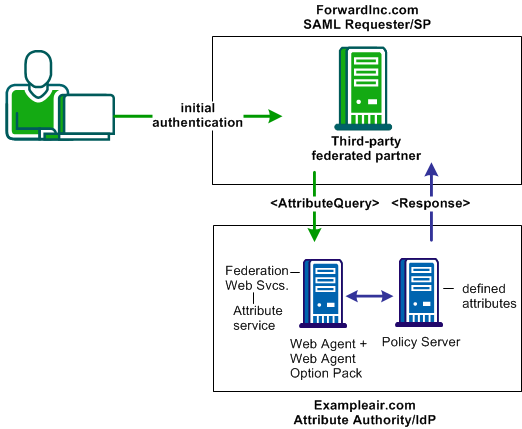
Note: The SPS federation gateway can replace the Web Agent and Web Agent Option Pack to provide the Federation Web Services application functions. For information about installing and configuring the SPS federation gateway, see the Secure Proxy Server Administration Guide.
In this deployment,
Note: CA SiteMinder® must be serving as an IdP to implement the attribute query profile. This means that CA SiteMinder® can only be an Attribute Authority and respond to attribute queries. CA SiteMinder® cannot serve as an SP and cannot send attribute queries.
Forwardinc.com is acting as a SAML Requester. When a customer logs in at this site, the following sequence of events occurs:
In Use Case 10, discounts.com purchases widgets from smwidgets.com.
A buyer for discounts.com clicks on a link to access the latest widget price list at smwidgets.com. The buyer is taken to the smwidgets.com website and presented with the price list without having to log in to the discounts.com website.
The following illustration shows this use case.
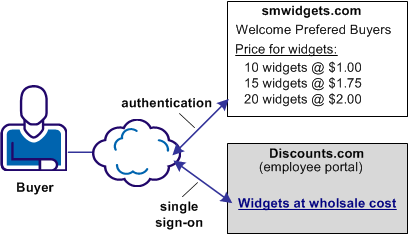
A buyer at discounts.com wants the price list at smwidgets.com There are no buyer identities stored locally, so discounts.com wants to obtain an identity for the buyer at smwidgets.com. Discounts.com sends an authentication request to smwidgets.com. When smwidgets.com receives the request, it generates a unique persistent identity for the buyer and adds this identity to the assertion. Discounts.com uses this unique identifier to authenticate the user and allow the buyer access to the requested resource.
Solution 10 shows how CA SiteMinder® legacy federation can be deployed at smcompany.com and discounts.com to solve Use Case 10: SAML 2.0 Single Sign-on with No Name ID at the IdP.
CA SiteMinder® is deployed at discounts.com and smwidgets.com. A Web Agent and Web Agent Option pack is installed on one system, and the Policy Server with legacy federation is installed on another system.
In the following illustration, smwidgets.com is acting as the Identity Provider and discounts.com is acting as the Service Provider.
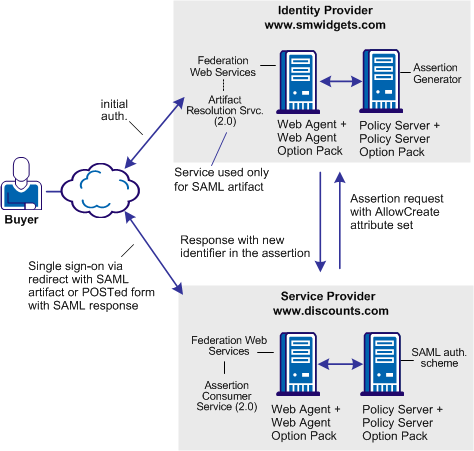
Note: The SPS federation gateway can replace the Web Agent and Web Agent Option Pack to provide the Federation Web Services application functions. For information about installing and configuring the SPS federation gateway, see the Secure Proxy Server Administration Guide.
For single sign-on between the two sites, where there is no federated user identity at the Identity Provider, the sequence of events is as follows:
If the Policy Server cannot find a value for the telephone number attribute, it verifies its configuration for the AllowCreate option. If this option is configured, the Policy Server searches the authentication request from the Service Provider to see if the AllowCreate option exists.
If the Allow/Create feature is enabled at both sites, the Policy Server generates a new identifier for the user attribute. The Policy Server places that identifier in its user store.
Note: The identifier is the value of the user attribute.
In use case 11, CompanyA, the producer site, wants to protect Web Agent applications and federated partner resources. The protocols that CompanyA uses for federated single sign-on are the SAML 2.0 artifact profile and SAML 2.0 single logoff.
For federated resources, a persistent user session is required because the SAML artifact profile stores assertions in the session store at the producer-side Policy Server. Consequently, calls are made to the session store to retrieve the assertion, impacting performance.
The following illustration shows a producer site that combines a federated environment and a web application environment.

Solution 11 illustrates how you can set up a parallel web application and federation environments to solve Use Case 11.
A security zone is a segment of a single cookie domain, which is used as a method of partitioning applications. You can assign different security requirements to each zone. Producer-side Web Agents that protect requested federated resources enforce security zones. CA SiteMinder® security zones eliminate the need for a persistent user session to be associated with every request for HTTP-Artifact protected applications.
The following figure illustrates a deployment that uses two different CA SiteMinder® environments at a single asserting party. One CA SiteMinder® environment is for federation functionality and the other is for web application protection.
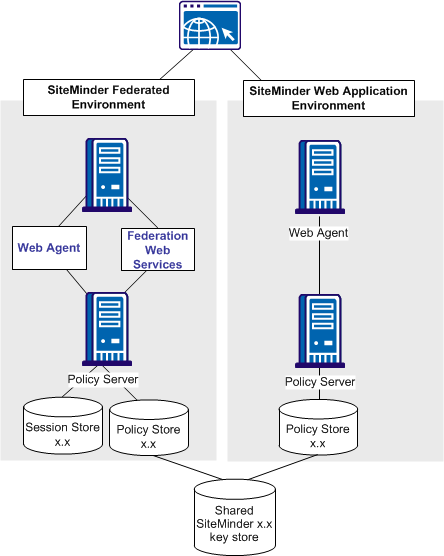
Note: The SPS federation gateway can replace the Web Agent and Web Agent Option Pack to provide the Federation Web Services application functions. For information about installing and configuring the SPS federation gateway, see the Secure Proxy Server Administration Guide.
The figure reflects the following set up:
Web application environment
|
Agent Configuration Object or Local Configuration File |
Trusted Security Zones |
Cookies Read by the Web Agent for the Zone |
|---|---|---|
|
DefaultAgent |
SM (default)--primary zone |
The DefaultAgent configuration enables the Web Agent to read and write the default session cookie, SMSESSION. |
Federation Environment
|
Agent Configuration Object or Local Configuration File |
Trusted Security Zones |
Cookies Read by the Web Agent for the Zone |
|---|---|---|
|
FedWA used by the Web Agent |
FED--primary zone SM--additionally accepted zone |
The FedWA configuration enables the Web Agent to read and write SESSIONSIGNOUT cookies, and read SMSESSION cookies. |
|
FedFWS used by the FWS application |
FED--primary zone only |
Configures the FWS to read and write SESSIONSIGNOUT cookies. |
All resources protected in the web application environment use non-persistent user sessions. As a result, when users are authenticated and authorized, the SMSESSION cookie contains a non-persistent user session specification. The non-persistent session specification helps ensure that requests to web applications do not incur the performance penalty of calling the session store.
When the Web Agent in the federation environment receives a request, this request is directed to the Authentication URL to establish a user session. The user making the request already has an SMSESSION cookie from the prior authentication in the web application environment. However, the user has no SESSIONSIGNOUT cookie.
The Web Agent in the federation environment writes a SESSIONSIGNOUT cookie. The SESSIONSIGNOUT cookie has a persistent user session specification and it uses the same session ID as the SMSESSION cookie. This persistent user session protects the Authentication URL, which authenticates users federating to a partner site.
The Web Agent in the federation environment reads the SMSESSION cookie and writes a SESSIONSIGNOUT cookie in accordance with the security zones associated with the FedWA configuration.
The Federation Web Services application in the federation environment reads the SESSIONSIGNOUT cookie. Because the cookie contains a persistent user session, a call to the session store is not necessary. The Federation Web Services application successfully processes the federation request that requires a persistent user session.
In use case 12, an Identity Provider, IdPA.com, wants to include web application attributes in an assertion. This use case is only applicable to SAML 2.0 deployments.
For this use case, single sign-on can be initiated at the Identity Provider or the Service Provider. The profiles that IdPA.com uses is SAML 2.0 (POST and Artifact) and WS-Federation.
The following figure shows an example of this use case.
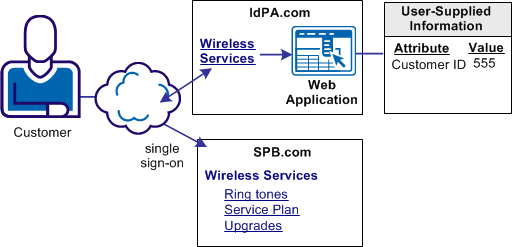
IdP-initiated Single Sign-on with Web Application Attributes
IdPA.com has a web application that allows access to protected resources at its business partner SPB.com. When the customer logs in at IdPA.com, they select a link for the business partner. The user is sent to the web application, where they are prompted to enter a customer ID. IdPA.com must send this information to SPB.com so that the customer is permitted access to the requested resource.
SP-initiated Single Sign-on with Web Application Attributes
A customer selects a link at SPB.com, the Service Provider. This link is for protected resources, so the customer is redirected to IdpA.com to be authenticated. After the customer successfully authenticates at IdPA.com, the IdP redirects the customer to the web application where the customer provides specific user information. Upon submitting the information, the customer is returned to SPB.com to complete single sign-on for the requested resource.
Solution 12 shows how CA SiteMinder® legacy federation can be deployed at IdPA.com and SPB.com to solve Use Case 12.
CA SiteMinder® is deployed at both sites. At each site, the Web Agent and the Web Agent Option pack are installed on one system, and the Policy Server is installed on another system.
In the following illustration, IdPA.com is the Identity Provider and SPB.com is the Service Provider and single sign-on is initiated at the Identity Provider.
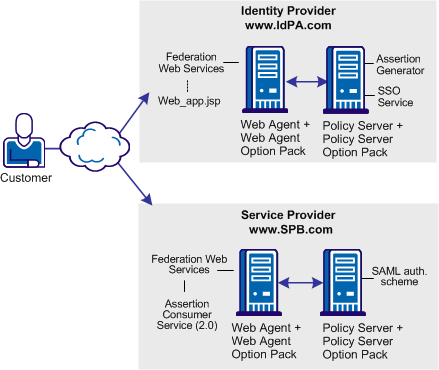
Note: The SPS federation gateway can replace the Web Agent and Web Agent Option Pack to provide the Federation Web Services application functions. For information about installing and configuring the SPS federation gateway, see the Secure Proxy Server Administration Guide.
For IdP-initiated single sign-on, the sequence of events is
Important! When the user goes to the SSO Service first, several query parameters (SPID, ProtocolBinding, RelayState) are included with the original SSO request. The SSO service groups this query data into one query parameter named SMPORTALSTATE, and then redirects the user (through a GET) to the web application.
Note: After the user is locally authenticated at the IdP, the user is never redirected to the Authentication URL if the session is valid.
Important! The web application must maintain and POST the SMPORTALSTATE query parameter and the collected attributes back to the SSO Service.
Important! The SSO Service makes all the attributes available to the Assertion Generator. Write and configure the assertion generator plug-in to add the attributes to the assertion.
For SP-initiated single sign-on:
Note: In the SP-initiated single sign-on, the request must arrive at the SSO service directly from the SP, as the SAML specification requires. The user cannot go directly to the web application.
Important! When the user is directed to the SSO Service, several query parameters (SPID, ProtocolBinding, RelayState) are included with the original request. The SSO service groups this query data into one query parameter named SMPORTALSTATE, and then redirects the user (through a GET) to the web application.
Important! The web application must maintain and POST the SMPORTALSTATE query parameter and the collected attributes back to the SSO Service.
Note: Write and configure an assertion generator plug-in to add the attributes to the assertion.
Configuring single sign-on based on attributes from a web application, requires specific steps.
Follow these steps:
Important! For IdP-initiated single sign-on, if the user is directed to the web application before the SSO service, the web application must include the parameter AllowApplicationPost=yes. The SSO service accepts the post as long as the application includes the AllowApplicationPost parameter.
The CA SiteMinder® Web Agent Option Pack comes with sample JSP applications that you can use as a basis for your custom web application. The path to the sample JSP applications is: web_agent_home/affwebservices/. The sample applications are:
This sample application can be used for IdP- or SP-initiated single sign-on. The user is first directed to the SSO Service and then sent to the custom web application. This application can be entered for the Application URL in the Service Provider Properties (SAML 2.0) dialog or the Resource Provider Properties (WS-Federation) dialog.
This sample application can be used for IdP-initiated single sign-on. The user is sent directly to the web application and not to the SSO Service. The application assumes that the user is already authenticated at the Identity Provider.
Note: This file shows how to use the AllowApplicationPost parameter in an application.
Note: The order of the procedure steps is provided as a guideline. You can perform these steps in a different order.
In Use Case 13, the IdP, discounts.com, includes an attribute named buyerID that identifies a particular user and is included in an assertion. When the assertion is sent to the Service Provider, smwidgets.com, the same attribute does not exist in the user record at the Service Provider. The Service Provider must create an attribute in the appropriate user record so that the user can authenticate and gain access to the protected resource.
An employee of discounts.com selects a link to access the latest price list on widgets at smwidgets.com. The employee logs in with the name and buyer ID.
The following illustration shows this use case.
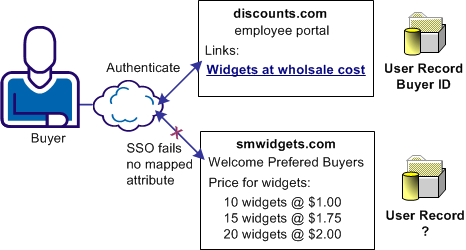
The identity that is based on the buyer ID of the user is created at discounts.com and placed in the assertion. The buyer ID value is entered as the NameID in the assertion. However, there is no mapped identity at smwidgets.com for the buyer ID. The administrator at the Service Provider establishes a mapping. The mapping has to use dynamic account linking so that smwidgets can authenticate the employee and can allow the employee access to the price list.
Solution 13 shows how CA SiteMinder® legacy federation can be deployed at IdPA.com and SPB.com to solve Use Case 13.
Note: Dynamic account linking is only supported with SAML 2.0.
CA SiteMinder® is deployed at both sites. Each site has a Web Agent and Web Agent Option Pack installed on one system, and the Policy Server on another system.
The following illustration shows single sign-on with dynamic account linking at the Service Provider.
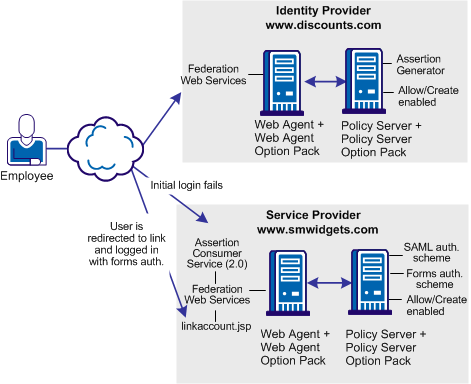
Note: The SPS federation gateway can replace the Web Agent and Web Agent Option Pack to provide the Federation Web Services application functions. For information about installing and configuring the SPS federation gateway, see the Secure Proxy Server Administration Guide.
The order of events for this solution is
Note: The linkaccount.jsp file must be part of a protected realm. The default location for this file is http://sp_home/affwebservices/public/. Copy the file from this location to a protected realm.
The search specification configured in the SAML 2.0 authentication scheme indicates which attribute is mapped to the NameID. In this case, the search specification is buyerID=%s.
The next time that the same user presents an assertion with the buyer ID, the user successfully gains access to the requested resource.
Configure several components at the Service Provider to enable SAML 2.0 single sign-on with dynamic account linking:
Enables the creation of attributes in an existing user store.
Sends the user to the linkaccount.jsp file when authentication fails. An authentication protects the redirect URL. The scheme requests the user to log in to create a SiteMinder session.
Must be enabled at the Service Provider Web Agent.
Indicates which attribute the NameID from the assertion replaces
Enable dynamic account linking for POST or Artifact single sign-on at the Service Provider
Follow these steps:
Note: The accountlinking must be set to yes (accountlinking=yes).
The default location for this file is http://sp_home/affwebservices/public/.
To protect resources with an authentication scheme, refer to information about authentication schemes in the Policy Server Configuration Guide.
The redirect URL is part of the SAML 2.0 authentication scheme setup at the Service Provider.
Complete the following fields with the values shown:
http://sp_home/protected_realm/linkaccount.jsp
Example: http://smwidgets.com/partner_resources/linkaccount.jsp
The default location of the linkaccount.jsp file is http://sp_home/affwebservices/public/. Copy the file from this directory to a directory that is configured as a protected realm.
HTTP POST
|
Copyright © 2015 CA Technologies.
All rights reserved.
|
|